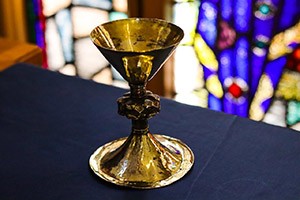Rare 15th Century Irish Chalice on Exhibit at Villanova University Art Gallery
“Thirst for the Divine” opens March 9 at 6 p.m.

VILLANOVA, Pa. – Made of silver gilt in the late 15th century, it was discovered in a cardboard box in a garden outbuilding in England—centuries after it was likely looted from an Irish church or monastery. Villanova University is the very first to exhibit a rare and historical Irish chalice in “Thirst for the Divine,” an exhibition at the Villanova Art Gallery that runs March 9 to April 20, 2022. The exhibit opens March 9 at 6 p.m. with talks by Villanova faculty who specialize in medieval art and history. The event is free and open to the public.
“Thirst for the Divine” also encompasses “Birds of Longing: Exile and Memory,” an exhibit of the work of contemporary fiber and cloth artist Laurie Wohl. Her pieces interweave Christian, Jewish and Muslim spiritual writings from the Convivencia in Spain (8th to 15th centuries) with contemporary Middle Eastern poetry. The exhibit brings the medieval into conversation with spiritually inspired art from the present.
When King Henry VIII broke ties with the Catholic Church and founded the Church of England during his reign (1509-1547), he ordered a reform of religious life and institutions and the dissolution of monasteries in both England and Ireland. The chalice’s exhibition, which is co-sponsored by Villanova’s Center for Irish Studies, is a celebration of Irish art, history and culture as well as of the survival of the Roman Catholic faith in Ireland through difficult times.
Only a handful of chalices from its era still exist, suggesting it may have been hidden or buried after its removal from Ireland.
“The chalice’s provenance is an amazing story and an amazing mystery,” said Joseph Lennon, PhD, associate dean, International and Interdisciplinary Initiatives and the Emily C. Riley Director of Irish Studies. “The chalice was likely taken by Cromwellian soldiers after burning or looting a monastery near Cork or southern Ireland.”
The historical piece had been stored for much of the past century in a simple box in the stables of a manor house in Devon, England, and its owners had had no idea of how rare it was. It was sold at an auction in July 2021 and is on loan to Villanova from an Irish entrepreneur and friend of the Center.
On Sunday, March 20 at 10:30 a.m., the chalice will be used in a Mass celebrated by Villanova University President the Rev. Peter M. Donohue, OSA, PhD in St. Thomas of Villanova Church. Father Donohue will discuss the chalice in his homily.
The Villanova Art Gallery is in the Connelly Center on Villanova’s campus. The display case housing the chalice is custom made by Ethan Shaw, Ben Lamachia and Asher Gillman of EBA Studio, which works within the worlds of furniture, fine art and object design. The multidisciplinary creative studio was founded in Los Angeles in 2021.
About the Center for Irish Studies: The Center for Irish Studies at Villanova University has been a leader for four decades in interdisciplinary teaching and scholarship on Ireland in a global framework. The Center connects students to local community organizations while also preparing them to become citizens equipped to take on the world’s most pressing challenges. Through liberal arts-focused academics, multi-disciplinary scholarship and key partnerships, the Center provides students with research, study abroad and employment opportunities.
About Villanova University’s College of Liberal Arts and Sciences: Since its founding in 1842, Villanova University’s College of Liberal Arts and Sciences has cultivated knowledge, understanding and intellectual courage for a purposeful life in a challenging and changing world. With more than 40 majors across the humanities, social sciences and natural sciences, it is the oldest and largest of Villanova’s colleges, serving more than 4,500 undergraduate and graduate students each year. The College is committed to a teacher-scholar model, offering outstanding undergraduate and graduate research opportunities and a rigorous core curriculum that prepares students to become critical thinkers, strong communicators and ethical leaders with a truly global perspective.
